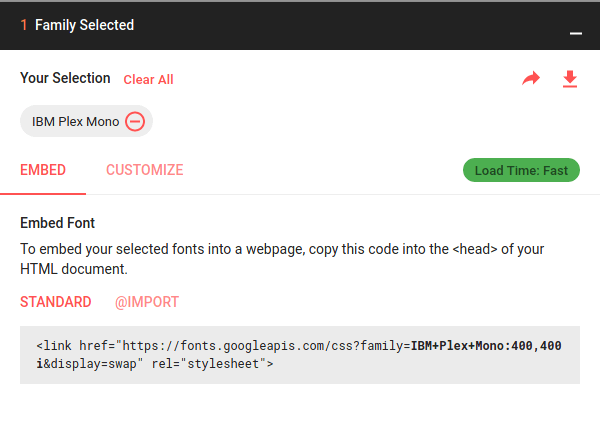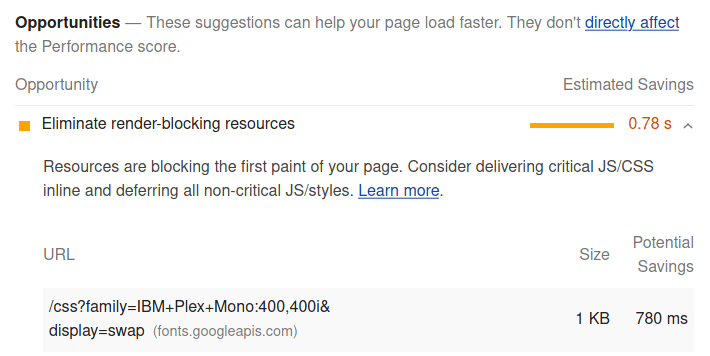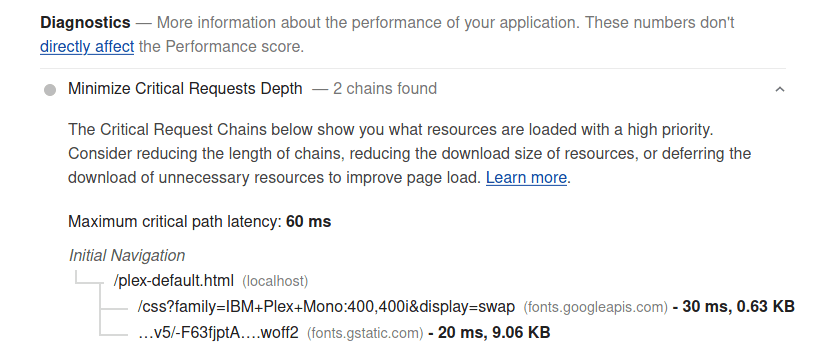Improve Page Speed when Using Google Fonts
Recently, I started working on a small web application that converts tables copied from spreadsheets and websites into well-formatted Markdown tables. (Check out a pre-launch version at Table to Markdown!) I wanted the site to be minimalist but not too boring, so I opted to use a custom font from Google Fonts to add one piece of flair.
The font I chose is IBM Plex Mono, a monospaced font from IBM. It's easy-to-read and has interesting italics, which makes it a good fit for a Markdown-focused website.
That nice-looking font comes at a price, however: page load times.
Adding a custom Google Font, instead of using an OS-native font stack like Bootstrap does, inevitably increases page load times. Instead of a loading all web resources from your own server, adding a Google Font means that your website now depends on font files from Google's servers, too.
If you've read my post about building this blog with Pelican, you'll know that I like quick page loads. Google's PageSpeed Insights ranks website page load times out of 100, and 100/100 is always my goal.
So, how can a person use Google Fonts without sacrificing too much in page load speed? This post will answer that question, and I hope it will also serve as a blueprint for how to research and improve page load times in general.
Let's start by seeing why Google Fonts slows down page loads, then looking at how we can limit that performance penalty.
Default Google Font loading
When you find a funky font at Google Fonts and you're ready to use it, the instructions look a little like this:

Easy enough! Add that <link> element to the <head> of your website, and you're ready to use your selected typeface in your CSS font-family rules.
That's just what I did for this HTML document:
<!DOCTYPE html>
<html lang="en">
<head>
<meta charset="UTF-8" />
<title>With IBM Plex, Default</title>
<!-- Default Google Font loading -->
<link
href="https://fonts.googleapis.com/css?family=IBM+Plex+Mono:400,400i&display=swap"
rel="stylesheet"
/>
<style>
body {
font-family: "IBM Plex Mono", monospace;
}
</style>
</head>
<body>
<h1>This should be in IBM Plex Mono</h1>
</body>
</html>
This webpage doesn't look like much, and that's the idea. Because this HTML contains almost nothing, it will give us a good sense of how much the Google Font is impacting our page loads.
To test how this Google Font impacts page load performance, I used the performance audit in Chromium's DevTools. This audit uses Lighthouse, the same tool that powers PageSpeed Insights.
Here's how you can follow along:
- Copy the above HTML file to a directory on your machine, and name it
index.html - Launch an HTTP server in the same directory
- I use Python's
http.server:python -m http.server 8000
- I use Python's
- Visit http://localhost:8000 in Chromium or Chrome
- In the developer tools, navigate to the "Audits" tab
- Under "Throttling" Select "Simulated Slow 4G, 4x CPU slowdown"
- Click "Run audits" at the bottom of the tab
And here are the performance audit results:

At first blush, this looks good! After all, the performance is 100/100. But this 100 is a soft 100.
Let's check out the "Diagnostics" section:

It says that if we "Eliminate render-blocking resources", we could load this page 0.78s faster. Let's find out what that means and how it can improve page loads.
Google Fonts page speed impact
Using the recommended method to add a Google Font into a webpage can slow a page load by a whopping 780ms.
The audit calls this a "render-blocking resource", which means that the page can't load until this CSS file has been fetched from the Google Fonts server, fonts.googleapis.com.
Is there anything I can do about that? After all, I did opt to use a font from a third-party service. The performance audit answers this question in the "Diagnostics" section:

Huh. To load a font from Google Fonts, the browser has to:
- Fetch the HTML (it's hard to show a webpage without HTML)
- Fetch a file at fonts.googleapis.com/css
- Fetch the font file (with a
.woff2extension) from fonts.gstatic.com (the custom font)
This three-step process is a "Critical Rendering Path", or CRP, between a user's browser and the resources necssary to display a webpage. In this case, there looks to be an extra step that could add 30ms to a page load.
Google provides three recommendations to optimize CRP:
- Minimizing the number of critical resources: eliminating them, deferring their download, marking them as async, and so on.
- Optimizing the number of critical bytes to reduce the download time (number of roundtrips).
- Optimizing the order in which the remaining critical resources are loaded: downloading all critical assets as early as possible to shorten the critical path length.
In short: use fewer, smaller critical resources, and load them as soon as possible.
To see how we can optimize the CRP to load a Google Font, let's see what https://fonts.googleapis.com/css?family=IBM+Plex+Mono:400,400i&display=swap returns:
/* cyrillic-ext */
@font-face {
font-family: "IBM Plex Mono";
font-style: italic;
font-weight: 400;
font-display: swap;
src: local("IBM Plex Mono Italic"), local("IBMPlexMono-Italic"),
url(https://fonts.gstatic.com/s/ibmplexmono/v5/-F6pfjptAgt5VM-kVkqdyU8n1ioa2Hdgv-s.woff2)
format("woff2");
unicode-range: U+0460-052F, U+1C80-1C88, U+20B4, U+2DE0-2DFF, U+A640-A69F,
U+FE2E-FE2F;
}
/* cyrillic */
@font-face {
font-family: "IBM Plex Mono";
font-style: italic;
font-weight: 400;
font-display: swap;
src: local("IBM Plex Mono Italic"), local("IBMPlexMono-Italic"),
url(https://fonts.gstatic.com/s/ibmplexmono/v5/-F6pfjptAgt5VM-kVkqdyU8n1ioa0Xdgv-s.woff2)
format("woff2");
unicode-range: U+0400-045F, U+0490-0491, U+04B0-04B1, U+2116;
}
/* vietnamese */
@font-face {
font-family: "IBM Plex Mono";
font-style: italic;
font-weight: 400;
font-display: swap;
src: local("IBM Plex Mono Italic"), local("IBMPlexMono-Italic"),
url(https://fonts.gstatic.com/s/ibmplexmono/v5/-F6pfjptAgt5VM-kVkqdyU8n1ioa2ndgv-s.woff2)
format("woff2");
unicode-range: U+0102-0103, U+0110-0111, U+1EA0-1EF9, U+20AB;
}
/* latin-ext */
@font-face {
font-family: "IBM Plex Mono";
font-style: italic;
font-weight: 400;
font-display: swap;
src: local("IBM Plex Mono Italic"), local("IBMPlexMono-Italic"),
url(https://fonts.gstatic.com/s/ibmplexmono/v5/-F6pfjptAgt5VM-kVkqdyU8n1ioa23dgv-s.woff2)
format("woff2");
unicode-range: U+0100-024F, U+0259, U+1E00-1EFF, U+2020, U+20A0-20AB,
U+20AD-20CF, U+2113, U+2C60-2C7F, U+A720-A7FF;
}
/* latin */
@font-face {
font-family: "IBM Plex Mono";
font-style: italic;
font-weight: 400;
font-display: swap;
src: local("IBM Plex Mono Italic"), local("IBMPlexMono-Italic"),
url(https://fonts.gstatic.com/s/ibmplexmono/v5/-F6pfjptAgt5VM-kVkqdyU8n1ioa1Xdg.woff2)
format("woff2");
unicode-range: U+0000-00FF, U+0131, U+0152-0153, U+02BB-02BC, U+02C6, U+02DA,
U+02DC, U+2000-206F, U+2074, U+20AC, U+2122, U+2191, U+2193, U+2212, U+2215,
U+FEFF, U+FFFD;
}
/* cyrillic-ext */
@font-face {
font-family: "IBM Plex Mono";
font-style: normal;
font-weight: 400;
font-display: swap;
src: local("IBM Plex Mono"), local("IBMPlexMono"),
url(https://fonts.gstatic.com/s/ibmplexmono/v5/-F63fjptAgt5VM-kVkqdyU8n1iIq129k.woff2)
format("woff2");
unicode-range: U+0460-052F, U+1C80-1C88, U+20B4, U+2DE0-2DFF, U+A640-A69F,
U+FE2E-FE2F;
}
/* cyrillic */
@font-face {
font-family: "IBM Plex Mono";
font-style: normal;
font-weight: 400;
font-display: swap;
src: local("IBM Plex Mono"), local("IBMPlexMono"),
url(https://fonts.gstatic.com/s/ibmplexmono/v5/-F63fjptAgt5VM-kVkqdyU8n1isq129k.woff2)
format("woff2");
unicode-range: U+0400-045F, U+0490-0491, U+04B0-04B1, U+2116;
}
/* vietnamese */
@font-face {
font-family: "IBM Plex Mono";
font-style: normal;
font-weight: 400;
font-display: swap;
src: local("IBM Plex Mono"), local("IBMPlexMono"),
url(https://fonts.gstatic.com/s/ibmplexmono/v5/-F63fjptAgt5VM-kVkqdyU8n1iAq129k.woff2)
format("woff2");
unicode-range: U+0102-0103, U+0110-0111, U+1EA0-1EF9, U+20AB;
}
/* latin-ext */
@font-face {
font-family: "IBM Plex Mono";
font-style: normal;
font-weight: 400;
font-display: swap;
src: local("IBM Plex Mono"), local("IBMPlexMono"),
url(https://fonts.gstatic.com/s/ibmplexmono/v5/-F63fjptAgt5VM-kVkqdyU8n1iEq129k.woff2)
format("woff2");
unicode-range: U+0100-024F, U+0259, U+1E00-1EFF, U+2020, U+20A0-20AB,
U+20AD-20CF, U+2113, U+2C60-2C7F, U+A720-A7FF;
}
/* latin */
@font-face {
font-family: "IBM Plex Mono";
font-style: normal;
font-weight: 400;
font-display: swap;
src: local("IBM Plex Mono"), local("IBMPlexMono"),
url(https://fonts.gstatic.com/s/ibmplexmono/v5/-F63fjptAgt5VM-kVkqdyU8n1i8q1w.woff2)
format("woff2");
unicode-range: U+0000-00FF, U+0131, U+0152-0153, U+02BB-02BC, U+02C6, U+02DA,
U+02DC, U+2000-206F, U+2074, U+20AC, U+2122, U+2191, U+2193, U+2212, U+2215,
U+FEFF, U+FFFD;
}
Well, would you look at that? It's just a CSS file with @font-face rules to load IBM Plex Mono font files.
This means that if we use the default Google Fonts way of loading a font, before we even start loading the font files, we have to do an additional request to get the CSS containing links to those font files. The Google Fonts API tells the browser to cache font responses, so subsequent page loads will be faster than this initial load.
Still, what if we could load a Google Font in one request?
Inlined Google Font loading
To load a Google Font in one request instead of two, we need to elimitate the CRP-lengthening stylesheet request.
How? The "Opportunities" section of the Lighthouse audit told us from the start:
Resources are blocking the first paint of your page. Consider delivering critical JS/CSS inline [emphasis added] and deferring all non-critical JS/styles.
The CSS that loads our custom font certainly counts as 'critical'. To inline it, we just need to add its CSS contents in a <style> tag in our HTML file:
<!DOCTYPE html>
<html lang="en">
<head>
<meta charset="UTF-8" />
<title>With IBM Plex, Inlined</title>
<style>
body {
font-family: "IBM Plex Mono", monospace;
}
</style>
<!-- Inlined Google Font loading -->
<style>
@font-face {
font-family: "IBM Plex Mono";
font-style: italic;
font-weight: 400;
font-display: swap;
src: local("IBM Plex Mono Italic"), local("IBMPlexMono-Italic"),
url(https://fonts.gstatic.com/s/ibmplexmono/v5/-F6pfjptAgt5VM-kVkqdyU8n1ioa1Xdg.woff2)
format("woff2");
unicode-range: U+0000-00FF, U+0131, U+0152-0153, U+02BB-02BC, U+02C6,
U+02DA, U+02DC, U+2000-206F, U+2074, U+20AC, U+2122, U+2191, U+2193,
U+2212, U+2215, U+FEFF, U+FFFD;
}
@font-face {
font-family: "IBM Plex Mono";
font-style: normal;
font-weight: 400;
font-display: swap;
src: local("IBM Plex Mono"), local("IBMPlexMono"),
url(https://fonts.gstatic.com/s/ibmplexmono/v5/-F63fjptAgt5VM-kVkqdyU8n1i8q1w.woff2)
format("woff2");
unicode-range: U+0000-00FF, U+0131, U+0152-0153, U+02BB-02BC, U+02C6,
U+02DA, U+02DC, U+2000-206F, U+2074, U+20AC, U+2122, U+2191, U+2193,
U+2212, U+2215, U+FEFF, U+FFFD;
}
</style>
</head>
<body>
<h1>This should be in IBM Plex Mono</h1>
</body>
</html>
By replacing the Google Fonts <link rel="stylesheet" /> with inline CSS, we're able to deliver critical CSS without incurring the performance impact of an additional request.
You may notice one other change, too: fewer languages in the Google Fonts CSS. By removing rules for unused languages, this inlined CSS weights in under 1kb, compared with the 3.9kb for the CSS file with the rules for Cyrillic, Vietnamese, and Latin Extended.
These changes meet two of Google's recommendations for improving CRP:
- Minimizing the number of critical resources
- Optimizing the number of critical bytes to reduce the download time
Performance comparison
Now that we've eliminated an extra request by inlining the Google Fonts CSS, let's take a look at how much this improves page load performance.
Page load with default Google Fonts stylesheet

This page load took 1.79s with 17.5 KB of data, 14.5 KB transferred. The "Load" time here is a little misleading because the page is showing as loading before the font file has loaded.
Page load with inlined Google Fonts stylesheet

This page load took 1.22 s with 14.6 KB of data, 14.8 KB transferred.
Here, the inlined page load is 0.57 s faster than the page loading Google Fonts the default way, or a little over 30%. While the stylesheet containing the @font-face rules is small, every HTTP request has overhead. Eliminating an extra HTTP request means elminating that overhead, which means a faster page load.
Update: Viable alternatives
google-webfonts-helper makes it easy to download and self-host Google Fonts. It generates the stylesheet necessary to load custom font files from your web server along with the font files themselves.
Font Squirrel also offers a Webfont Generator that enables you to upload a local font file and convert it to a webfont.
Conclusion
If your website uses Google Fonts and you're loading those fonts the default way, you may want to consider a more performant option.
Inlining the CSS returned from the Google Fonts stylesheet reduces the number of critical resources to load a web font from two to one, but it comes at the cost of not having auto-updating font files. Removing unused languages from the stylesheet reduces the number of bytes needed to load the page, too, helping it load even faster—if only a little.
Self-hosting Google Fonts, with a hand from tools like google-webfonts-helper, is a bit more work to set up and maintain, but it eliminates third-party requests to Google Fonts.
With a bit of work ahead of time, you can use custom fonts and keep page load times in line with even the highest expectations.